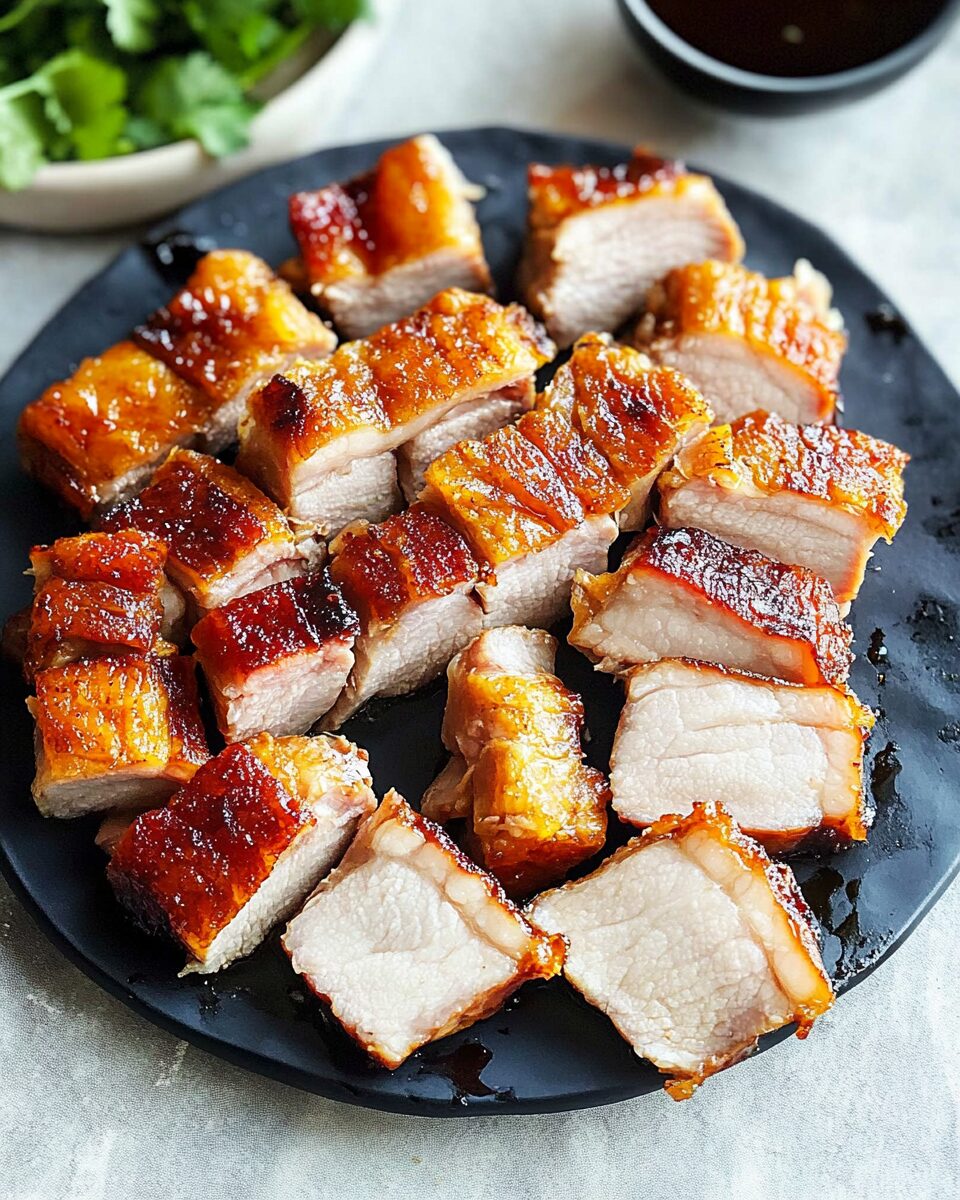Chinese Roast Pork, also known as Char Siu, is a popular Cantonese dish that blends sweet and savory flavors. The pork is marinated in a rich sauce before being roasted to perfection, resulting in a crispy exterior and a tender, juicy interior. This recipe provides a simple yet delicious way to recreate this iconic dish at home with minimal effort.
FULL RECIPE
Ingredients
- 2 lbs pork shoulder or pork belly, cut into strips
- 2 tbsp soy sauce
- 2 tbsp hoisin sauce
- 2 tbsp honey
- 2 tbsp Chinese rice wine or dry sherry
- 1 tbsp oyster sauce
- 1 tbsp Chinese five-spice powder
- 1 tsp sesame oil
- 1 clove garlic, minced
- 1 tbsp red food coloring (optional, for the traditional red hue)
Directions
- In a large bowl, whisk together the soy sauce, hoisin sauce, honey, rice wine, oyster sauce, five-spice powder, sesame oil, garlic, and red food coloring (if using) to make the marinade.
- Add the pork strips to the marinade and toss until fully coated. Cover and refrigerate for at least 4 hours, but preferably overnight for deeper flavor.
- Preheat the oven to 375°F (190°C).
- Line a baking sheet with aluminum foil and place a wire rack on top. Arrange the marinated pork strips in a single layer on the rack, ensuring space between each piece for even roasting.
- Roast the pork in the oven for 25-30 minutes, basting with the marinade every 10 minutes to build up a glossy, caramelized glaze. Continue roasting until the pork is fully cooked and the exterior is crispy and golden.
- Once cooked, remove from the oven and let the pork rest for 5 minutes before slicing.
- Slice the Chinese roast pork and serve with steamed rice or as a flavorful addition to stir-fries, noodles, or bao buns.
Nutritional Information
- Calories: 350-400 per serving
- Protein: 30-35 grams
- Fat: 20-25 grams
- Carbohydrates: 20-25 grams
- Fiber: 1-2 grams
- Sugar: 12-15 grams
History and Origins of Char Siu
Char Siu, a beloved Chinese dish, has deep roots in Cantonese cuisine. It is commonly associated with the regions of southern China, particularly Guangdong Province. The name “Char Siu” directly translates to “fork roast,” a reference to the traditional method of roasting meat on a long, metal skewer over an open flame. Over time, the dish evolved and is now often roasted in ovens, especially outside of China.
Choosing the Right Cut of Pork
When making Char Siu, it’s important to choose the right cut of pork to achieve the best texture and flavor. Pork shoulder is a popular choice due to its tenderness and marbling, which results in a juicy, flavorful roast. Pork belly, with its higher fat content, is another excellent option, providing a more indulgent and rich taste. It’s essential to cut the pork into long strips to ensure even cooking and easy slicing after roasting.
The Importance of Food Coloring in Char Siu
The vibrant red color of Char Siu is one of its most distinctive features. While the red hue traditionally came from the use of fermented red bean paste, many modern recipes rely on red food coloring to achieve the same effect. This visual appeal adds to the dish’s festive nature, especially during celebrations. However, the food coloring is purely decorative, and the flavor of the dish is not significantly affected by its use. It’s optional, but if you’re aiming for the traditional look, it’s a key ingredient.
Roasting Techniques for Perfect Char Siu
Achieving the perfect Char Siu involves mastering the roasting technique. While traditional methods involved roasting the pork over an open flame, modern recipes typically use an oven for convenience and consistency. The key is to roast the meat at a high temperature, allowing the outside to become caramelized and slightly crispy while keeping the inside juicy and tender. Basting the pork with the marinade every 10 minutes ensures that the meat stays moist and evenly coated with the flavorful sauce.
The Role of Basting in the Cooking Process
Basting is a critical part of making Char Siu. As the pork roasts, the marinade caramelizes, forming a glossy, sticky glaze on the surface of the meat. Basting every 10 minutes helps to build layers of flavor and ensures that the meat remains moist throughout the cooking process. It’s important to use the marinade generously to create that signature Char Siu glaze while preventing the pork from drying out.
Alternative Cooking Methods for Char Siu
While roasting in the oven is the most common method for cooking Char Siu, there are several other ways to prepare this dish. For instance, a grill or barbecue can be used to achieve the smoky flavor associated with traditional Char Siu. Additionally, some home cooks opt for using a slow cooker or instant pot to achieve tender results without the need for constant monitoring. Each method has its own advantages, but roasting in the oven is the most straightforward and reliable option.
Serving Suggestions for Char Siu
Char Siu is incredibly versatile and can be served in numerous ways. It is commonly eaten with steamed white rice or stir-fried vegetables, but it can also be used in buns (Char Siu Bao) or as a filling for dumplings. The dish pairs well with a variety of sauces, such as soy sauce, hoisin sauce, or even a sweet chili dip. It can also be sliced thinly and used as a topping for noodle soups or served as a side dish at a larger banquet.
Pairing Char Siu with Traditional Chinese Dishes
Char Siu is often part of a larger Chinese banquet, where it is paired with dishes like fried rice, stir-fried noodles, and vegetable dishes. The savory sweetness of Char Siu contrasts beautifully with the freshness of stir-fried greens or the richness of braised dishes. It can also complement dim sum or be served as part of a Chinese barbecue platter, alongside other favorites like roasted duck and Peking duck.
How to Store and Reheat Char Siu
If you happen to have leftovers, Char Siu can be stored in an airtight container in the refrigerator for up to 3-4 days. To reheat, place the meat in a preheated oven at 350°F (175°C) for about 10-15 minutes, or until heated through. For best results, you can also reheat it in a skillet to maintain the crispy texture on the outside. Char Siu can also be frozen for up to 2-3 months. Simply slice the meat before freezing, and store it in a freezer-safe bag.
Variations of Char Siu
Although the classic Char Siu recipe remains a favorite, there are several variations of the dish depending on the region and personal preference. Some recipes use a sweeter marinade, while others add more savory or spicy elements. In some regions, Char Siu is made with a tangy, vinegar-based sauce, while in others, the glaze might have a more pronounced honey or brown sugar flavor. There’s room for experimentation, and each version brings something unique to the table.
Char Siu in Other Cuisines
Char Siu has become popular outside of China, especially in areas with large Chinese communities. It is commonly found in Hong Kong-style cafes, called Cha Chaan Tengs, throughout the world. In some places, Char Siu has been adapted to suit local tastes, such as adding different spices or using alternative meats like chicken or beef. These adaptations have made Char Siu a global favorite, enjoyed in various forms from the Americas to Southeast Asia.
Nutritional Benefits of Char Siu
While Char Siu is a flavorful dish, it does have a rich nutritional profile. The pork provides a good source of protein and essential nutrients like iron, zinc, and B vitamins. However, due to its higher fat content, especially if using pork belly, it’s best to enjoy Char Siu in moderation. The marinade’s sugar content also adds to the calorie count, so it’s important to balance this dish with healthier options like vegetables or steamed rice.
Adjusting the Sweetness and Spice
One of the best aspects of Char Siu is the ability to adjust the marinade to your personal taste. Some may prefer a sweeter glaze, which can be achieved by adding more honey or brown sugar to the marinade. On the other hand, if you prefer a spicier version, adding chili flakes or a bit of Sriracha sauce can add an exciting kick to the dish. Experimenting with the balance of flavors allows you to create a Char Siu recipe that suits your palate perfectly.
How to Achieve the Perfect Char Siu Glaze
The signature glaze of Char Siu is achieved by allowing the marinade to caramelize during the roasting process. To achieve the perfect glaze, ensure that you baste the meat frequently while roasting. This will help to form that shiny, sticky coating that is synonymous with Char Siu. Don’t skip this step—without it, the dish will lack the iconic texture and visual appeal.
Char Siu as Part of Dim Sum
Char Siu is commonly used as a filling for Dim Sum, particularly in the form of Char Siu Bao, or steamed buns. The buns are soft and fluffy, filled with the savory-sweet pork, making for a delightful bite. Char Siu Bao is a popular choice at Dim Sum restaurants, often served in baskets alongside other types of buns and dumplings. The combination of tender pork and delicate steamed dough creates an unforgettable culinary experience.
Conclusion
Char Siu is much more than just a dish it’s a culinary tradition that embodies the rich flavors and techniques of Cantonese cooking. From its sweet and savory marinade to its tender, caramelized texture, it is a meal that appeals to the senses and celebrates the art of roasting. Whether you’re preparing it for a special occasion or a casual family dinner, Char Siu never fails to impress.






